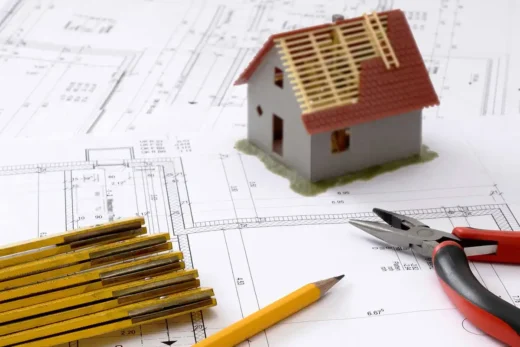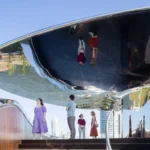Modular and prefabricated construction rise in 2025, Future house construction, Residential property design
The Rise of Modular and Prefabricated Construction in 2025
22 May 2025
Modular and prefabricated construction has transformed from an alternative building method to a mainstream approach, reshaping the global construction industry. This manufacturing-based building process, where structural components are created in controlled factory environments before transportation to construction sites for assembly, has gained significant traction as developers seek faster, more cost-effective, and sustainable building solutions. Current adoption rates show year-over-year growth of 5.7% globally, with particular acceleration in metropolitan areas experiencing housing shortages and rapid development needs.
Many construction firms have embraced this transformation, including general contractors like https://jcconstruction.us/general-contracting/ who serve the Sacramento region and have integrated modular techniques into their traditional building approaches. These professionals recognize that factory-built components’ efficiency gains and quality control advantages often outweigh the initial learning curve and adjustment to new methodologies. The shift represents a fundamental rethinking of construction sequencing and project management approaches that have remained relatively unchanged for generations.
The modular construction market reached $95.1 billion in 2024, and projects indicate growth to approximately $131.2 billion by 2030. There has been particularly strong development in multifamily housing, healthcare facilities, educational institutions, and hospitality. Regional adoption varies significantly, with Scandinavian countries leading at 45% market penetration, North America reaching 15% with rapid growth, and Asia-Pacific regions experiencing the fastest acceleration driven by urbanization pressures and governmental housing initiatives.
Readers should note that modular construction approaches vary significantly in application and regulatory requirements across different regions and municipalities. Construction professionals should verify local codes and requirements before implementing modular methods in specific jurisdictions.
Understanding Modern Modular Construction Methods and Technologies
Modern modular construction represents a sophisticated evolution of prefabrication techniques that leverage advanced manufacturing processes, digital design tools, and engineered materials to create high-performance building components. These systems range from panelized elements to fully volumetric modules with finishes, fixtures, and integrated building systems. The approach redefines construction as an assembly process rather than an on-site fabrication activity, shifting most labor hours to controlled factory environments.
How Factory-Built Construction Has Evolved Beyond Traditional Prefab
The evolution from basic prefabricated components to sophisticated modular systems represents a quantum leap in building technology. Early prefab limited itself primarily to panelized walls and simple structural elements. At the same time, contemporary modular construction encompasses fully finished volumetric units containing complete rooms, apartments, or building sections finished with mechanical systems, fixtures, and finishes. This advancement has transformed building sites from areas of comprehensive construction to assembly locations where precision-manufactured components connect to form complete structures.
Digital design integration has revolutionized manufacturing through Building Information Modeling (BIM) and computational design tools that ensure millimeter-precision fabrication. These technologies enable complex buildings comprising hundreds of modules to fit seamlessly during assembly, whereas earlier prefab methods often required substantial on-site adjustment. Due to superior manufacturing conditions and quality control processes, the resulting structures now frequently exceed the quality of traditional site-built construction.
Traditional construction typically allocates 60-70% of project duration to on-site work, whereas modern modular approaches invert this ratio, with 70-80% of construction hours occurring in factory environments. This fundamental shift reduces weather dependency, increases worker productivity, and enables parallel processing where site preparation and foundation work proceed simultaneously with module fabrication. The result often reduces overall timelines by 30-50% while maintaining or improving quality metrics.
Construction professionals considering modular approaches should recognize that design decisions must be finalized earlier in the project timeline than in traditional methods. Changes after module fabrication begins typically incur significantly higher costs and scheduling impacts than similar changes in conventional construction.
Market Growth Driving Modular Innovation Across Industry Sectors
The expanding modular construction market has attracted significant investment in manufacturing capacity, technological development, and design innovation. This growth creates a virtuous cycle where increased adoption drives further advancement, expanding capabilities and applications across diverse building types. Manufacturing economies of scale increasingly improve cost competitiveness while specialized facilities develop expertise in specific building typologies, ranging from affordable housing to sophisticated healthcare environments.
Market expansion has incentivized substantial research and development investment in modular construction technologies. Multifamily residential leads adoption with 23% of new projects in North America incorporating significant modular elements, driven by housing shortages in urban centers and the need for accelerated delivery. Healthcare facilities follow at 18% adoption, valuing the reduced on-site construction disruption and superior quality control for sensitive medical environments. Education and hospitality sectors show 15% and 13% adoption, respectively, with standardized room configurations making these buildings particularly suitable for modular approaches.
Regional variations reveal interesting patterns, with Scandinavian countries maintaining their historical leadership in modular construction. Their long-standing expertise in factory-built housing has expanded to commercial applications, creating exportable knowledge and systems. North American markets show the most substantial growth in percentage terms, with modular adoption increasing approximately 8% annually as labor shortages and housing demands create fertile ground for alternative delivery methods. While starting from a lower adoption baseline, the Asia-Pacific region demonstrates the most aggressive growth trajectory with government-backed initiatives specifically promoting modular approaches for affordable housing development.
Investors and developers should consider that modular construction companies vary significantly in capabilities, financial stability, and quality control. Modular classrooms can be one element in building modern property. Due diligence regarding manufacturing capacity, delivery logistics, and completed project performance should precede partnership decisions with modular providers.
Business Benefits Driving Modular Construction Adoption
The rapid increase in modular construction adoption across diverse market sectors stems from compelling business advantages rather than merely following industry trends. These benefits encompass financial, operational, and risk-management improvements that create competitive advantages for early adopters while addressing persistent challenges in conventional construction. Forward-thinking organizations increasingly view modular methods as strategic advantages rather than alternative delivery options.
Project Timeline Advantages That Deliver Faster Occupancy
Time-to-market considerations increasingly drive delivery method decisions, particularly in competitive real estate markets or for time-sensitive facilities like schools and healthcare. Modular approaches compress overall project durations through manufacturing efficiencies and parallel processing capabilities that fundamentally restructure traditional construction sequencing. These timeline advantages translate directly to business benefits, including accelerated revenue generation, reduced financing costs, and competitive market positioning.
Schedule compression represents one of modular construction’s most compelling advantages, with typical projects achieving 30-50% faster completion than traditional methods. This acceleration stems from fundamental process changes rather than simply accelerating conventional techniques. By conducting 60-80% of construction activities in factory environments while simultaneously preparing the building site, projects effectively collapse critical path timelines through parallel processing, which is impossible in sequential site-built approaches.
Typically affecting 15-20% of traditional construction schedules, weather-related delays become largely irrelevant for the factory portion of modular projects. Manufacturing continues uninterrupted regardless of site conditions, maintaining productivity during seasons that often slow conventional construction. This predictability enables more accurate scheduling and reduces contingency requirements that cause uncertainty to project timelines.
Faster occupancy translates directly to financial benefits through earlier revenue generation for income-producing properties or reduced interim financing costs for all project types. Multifamily residential developments typically realize 3-4 additional months of rental income during the first year, while hotels capture corresponding operating revenue through earlier opening. These advantages compound in high-cost financing environments, improving project financial performance while accelerating return on investment.
Schedule advantages may be partially offset during initial organizational adoption of modular methods, as teams navigate learning curves associated with new processes. Construction managers should incorporate appropriate contingencies during early implementation phases while developing modular-specific expertise.
Quality Control Systems Ensuring Superior Building Performance
Building quality significantly impacts both short-term project success and long-term asset performance. Modular construction fundamentals quality management by migrating most production activities to controlled environments with standardized processes, worker specialization, and rigorous testing capabilities. This systematic approach addresses persistent quality challenges in traditional construction while creating comprehensive documentation throughout the building process.
Factory production fundamentally changes quality management through systematic process controls, which are impossible to implement in field construction. Manufacturing environments enable standardized testing protocols, consistent tool calibration, and environmental controls that eliminate variables affecting site-built construction quality. Each production station typically incorporates specific quality verification steps before components advance to subsequent phases, creating multiple inspection opportunities throughout assembly.
Digital quality tracking systems document every component from raw material through final installation, creating unprecedented traceability and accountability. These systems capture photographs, test results, and installer identification at critical points, establishing comprehensive quality documentation exceeding typical field construction records. The resulting database provides valuable information for building maintenance while creating transparent responsibility chains for any emerging performance issues.
Performance data increasingly demonstrates quality advantages through reduced warranty claims and post-completion defects. Projects utilizing significant modular components typically experience 70-85% fewer post-occupancy issue reports compared to similar conventionally built structures. Particular improvements appear in building envelope performance, mechanical system operation, and finish durability—areas where controlled manufacturing conditions and standardized processes directly impact quality outcomes.
Quality results depend significantly on the specific manufacturer’s processes and standards. Construction teams should thoroughly investigate quality control systems, review completed projects, and verify certification programs before selecting modular providers based solely on cost or schedule considerations.
Sustainability Advantages of Factory-Built Construction
Environmental considerations increasingly influence construction decisions as building owners, occupants, and communities prioritize sustainability. Modular construction offers inherent environmental advantages through manufacturing efficiency, waste reduction, and optimized material utilization that significantly reduce embodied carbon compared to conventional methods. These initial benefits complement operational performance improvements that extend sustainability advantages throughout building lifecycles.
Environmental Impact Reduction Through Precision Manufacturing
Construction waste constitutes approximately 30% of landfill volume in many regions, creating a substantial environmental impact through material disposal and production replacement. Modular manufacturing dramatically reduces this waste stream through precision cutting, optimized material ordering, and systematic recycling programs that are impossible to implement effectively on conventional construction sites. These improvements directly reduce embodied carbon while conserving resources through more efficient material utilization.
Material efficiency represents one of modular construction’s most significant environmental benefits, with waste reduction of 70-90% compared to traditional site-built methods. Factory settings enable precise cutting, optimal material utilization, and systematic recycling of manufacturing byproducts. Computer-controlled fabrication eliminates measurement errors that typically generate substantial waste in field conditions. At the same time, standardized processes allow materials to be ordered in exact quantities rather than with waste allowances standard in conventional construction.
Transportation impacts require careful analysis within sustainability evaluations, as module delivery involves moving partially empty volumes due to dimensional shipping constraints. However, comprehensive studies indicate net carbon reductions of 15-30% even after accounting for transportation factors. These benefits stem from dramatically reduced worker transportation requirements throughout construction, eliminating redundant material deliveries standard on conventional sites, and overall material efficiency gains.
Building operational performance frequently exceeds comparable site-built structures through superior insulation installation, reduced thermal bridging, and better air barrier continuity achieved in factory conditions. Energy modeling typically shows 8-15% efficiency improvements for modular buildings with identical design specifications to site-built alternatives. These gains translate directly to reduced carbon footprints throughout building lifespans, multiplying initial construction-phase sustainability benefits.
Environmental advantages may be partially offset if modules require long-distance transportation. Projects should consider manufacturing location relative to building sites when evaluating overall sustainability benefits, as transportation distances over 500 miles can significantly impact the net environmental equation.
Overcoming Challenges in Modular Construction Implementation
While modular construction offers compelling advantages, successful implementation requires addressing several significant challenges that differ from conventional construction approaches. These challenges encompass logistics, design constraints, regulatory considerations, and organizational change management. Organizations effectively navigating these obstacles position themselves to capture modular benefits while avoiding pitfalls that have hindered some early adopters.
Transportation Logistics – Solving the Module Mobility Problem
Physical module transportation between manufacturing facilities and building sites presents fundamental challenges influencing design decisions and project feasibility. Dimensional restrictions imposed by road regulations typically limit standard modules to approximately 16 feet wide, 60 feet long, and 14 feet high without special permits or escort vehicles, increasing costs and complexity. These constraints affect architectural possibilities while creating logistical challenges requiring specialized expertise, which is uncommon in traditional construction organizations.
Transportation constraints have historically limited modular construction’s application through dimensional restrictions on highway transport. Modern logistics approaches address these limitations through sophisticated route planning software that identifies optimal pathways for oversized loads while navigating dimensional limits. Real-time GPS tracking and specialized equipment developed for module transportation further reduce delivery risks while expanding module dimensions.
Recent innovations include foldable modules that compress for transportation before expanding at installation sites, doubling possible module widths without special permits. These systems utilize mechanical or hydraulic deployment systems that transform compact transportation configurations into full-sized building components upon arrival, enabling larger room sizes previously impossible within shipping constraints while reducing transportation costs through more efficient volume utilization.
The geographic relationship between manufacturing facilities and project sites significantly impacts transportation feasibility, with economics generally favoring facilities within 200-300 miles of building locations. This proximity requirement has driven the establishment of regional manufacturing networks rather than centralized production, creating economic development opportunities in areas with substantial construction activity while reducing carbon impacts associated with long-distance transportation.
Module transportation costs increase significantly when special permits, escort vehicles, or route modifications become necessary. Early planning should include a thorough transportation analysis to optimize module dimensions within standard shipping parameters when possible, potentially accepting additional on-site work to avoid excessive transportation expenses.
Regulatory Framework Evolution Supporting Modular Innovation
Regulatory systems developed for traditional construction sometimes create unintended barriers to modular approaches through requirements misaligned with factory production methods. These challenges include inspection timing, approval jurisdictions, and building code interpretations that assume on-site construction rather than factory assembly. Significant progress has occurred in addressing these barriers as regulatory agencies recognize modular construction’s growing importance and quality advantages.
Building code developments have increasingly recognized modular construction’s unique characteristics through specialized provisions addressing factory production and site assembly. These modifications acknowledge the quality advantages of controlled manufacturing environments while ensuring appropriate inspection protocols throughout the production and installation phases. The International Code Council has developed specific guidelines for modular construction that many jurisdictions have adopted, creating more consistent regulatory frameworks across different regions.
Third-party inspection agencies specializing in modular construction provide essential oversight throughout manufacturing processes, documenting compliance while components remain accessible for inspection. These agencies typically maintain full-time inspectors within manufacturing facilities rather than conducting periodic site visits, which is typical in traditional construction. They provide more comprehensive quality verification while streamlining approval processes through continuous documentation.
Cross-jurisdictional recognition programs increasingly facilitate module deployment across different regulatory environments by establishing reciprocity agreements for manufacturing inspection and approval. These programs reduce redundant reviews while maintaining quality standards, enabling efficient module deployment across state lines or between different local jurisdictions. This regulatory evolution supports regional manufacturing while eliminating duplicative compliance documentation previously required for multi-jurisdiction projects.
Despite regulatory advances, significant variations remain between jurisdictions regarding modular construction requirements. Project teams should engage with building officials early in planning processes to identify specific local requirements that might affect design, manufacturing, or approval processes.
Specialized Applications Driving Modular Construction Growth
Certain building types and market sectors have emerged as particularly suitable for modular approaches due to their spatial characteristics, performance requirements, or timeline pressures. These applications drive innovation while demonstrating modular construction’s capabilities across increasingly diverse and complex project types. Success in these specialized applications builds confidence while establishing performance track records that support broader industry adoption.
Affordable Housing Solutions Through Modular Efficiency
Housing affordability challenges represent one of society’s most persistent problems, with construction costs significantly impacting housing accessibility across diverse markets. Modular construction addresses this challenge through manufacturing efficiency, shortened construction financing periods, and reduced labor requirements that collectively improve housing delivery economics—these advantages position modular approaches as essential in addressing housing shortages affecting communities nationwide.
Housing affordability challenges have driven significant modular construction innovation, with standardized designs and manufacturing efficiency reducing costs while maintaining quality standards. Government agencies increasingly support modular approaches through specialized funding programs, streamlined approvals, and demonstration projects showcasing factory-built housing advantages. These initiatives recognize modular construction’s potential to deliver 20-30% faster housing units and 10-20% less expensively than conventional approaches while maintaining or improving quality.
Modular affordable housing projects benefit particularly from quality control advantages that ensure consistent performance across all units, rather than the variable quality often found in low-bid conventional construction. Factory production enables the reliable implementation of energy efficiency measures that reduce operational costs for residents while creating healthier living environments through proper ventilation, moisture control, and indoor air quality management.
Scalability represents another significant advantage for affordable housing applications. Once designs are approved and production lines are established, manufacturing capacity can produce hundreds or thousands of similar units. Given current labor constraints, this capacity enables large-scale housing initiatives that are impossible to deliver through conventional construction methods. The resulting production volume supports consistent housing delivery while creating manufacturing economies of scale that further improve affordability.
While modular construction offers clear advantages for affordable housing, successful implementation requires specialized design approaches that maximize standardization while addressing site-specific conditions. When planning such projects, teams should incorporate modular manufacturing expertise and affordable housing development experience.
Healthcare Facilities Benefiting From Precision Modular Construction
Healthcare environments present unique construction challenges through complex technical requirements, stringent performance standards, and operational disruption sensitivities that affect patient care. Modular construction addresses these challenges through precision manufacturing, quality control, and accelerated timelines that minimize disruption while ensuring compliance with rigorous healthcare facility standards. These advantages have positioned modular methods as increasingly valuable healthcare expansion and renovation approaches.
Healthcare construction has embraced modular approaches for expansions, renovations, and even complete facilities due to the exceptional precision possible in manufacturing environments. Medical equipment integration, specialized infrastructure for gases and fluids, and infection control requirements benefit from factory conditions where cleanliness standards exceed typical construction sites. The resulting spaces often outperform site-built equivalents in critical areas like air filtration, surface cleanliness, and systems integration.
Rapid deployment capabilities prove particularly valuable for healthcare. They allow capacity expansion in response to surges or emergencies without requiring extended construction disruption to existing operations. Modular operating rooms, patient rooms, and diagnostic areas can be installed during brief scheduled downtimes rather than requiring the extended occupancy disruptions typical of conventional construction in active healthcare environments.
Design standardization through modular approaches supports healthcare operational efficiency while incorporating evidence-based design principles proven to improve patient outcomes. Once optimal room configurations undergo validation through clinical assessment, manufacturing processes replicate these exact specifications across dozens or hundreds of identical modules. This standardization provides operational consistency while ensuring each space incorporates best practices rather than varying based on field construction variables.
Healthcare applications require specialized manufacturing expertise beyond standard modular production. Teams should verify that manufacturers have specific healthcare project experience and understand medical facility requirements, certification processes, and operational considerations unique to these specialized environments.
Future Innovations Reshaping Modular Construction
Technological advancement continues to accelerate modular construction capabilities while addressing previous limitations through innovations in materials, manufacturing processes, and digital integration. These developments expand modular applications to increasingly complex building types while improving performance, design flexibility, and economic competitiveness. Future innovations promise to enhance modular advantages further while overcoming remaining barriers to broader industry adoption.
Emerging Technologies Advancing Factory Building Systems
Manufacturing technology advancements borrowed from automotive, aerospace, and other industrial sectors increasingly transform modular construction production. These innovations improve precision, efficiency, and quality while reducing labor requirements and enabling more complex designs. Their implementation progressively addresses historical modular limitations while creating capabilities impossible in conventional construction environments.
Advancements in automation and robotics continue to transform modular manufacturing through precision fabrication systems that further enhance quality while reducing labor requirements. Computer-controlled cutting, assembly, and material handling systems achieve unprecedented accuracy while collecting detailed quality data throughout production. These technologies expand possible design complexity while ensuring consistent execution across thousands of components, enabling architectural expression previously challenging in modular formats.
Artificial intelligence applications in modular design optimization analyze thousands of configuration variables to identify the most efficient module arrangements, material selections, and manufacturing sequences. These systems balance competing priorities, including cost, schedule, transportation logistics, and sustainability metrics to generate optimized solutions beyond human analytical capabilities. The resulting improvements typically yield 5-15% additional efficiency compared to conventional design approaches.
Digital twin integration creates virtual models that precisely mirror physical modules throughout manufacturing, transportation, and assembly. These comprehensive digital representations enable precise coordination while simulating construction sequences before physical work begins. The resulting visualization capabilities virtually eliminate field coordination issues while providing clients unprecedented visibility into project progress throughout all development and construction phases.
While technology offers significant advantages, successful implementation requires substantial capital investment and organizational adaptation. Companies should develop comprehensive technology strategies with phased implementation plans rather than attempting complete transformation in a single step that might disrupt production continuity.
The Future Built Environment – Factory-Made and Field-Assembled
The construction industry is at a pivotal transformation point, where manufacturing methods increasingly complement or replace conventional building techniques. This evolution promises to address persistent industry challenges, including productivity stagnation, quality inconsistency, worker safety, and environmental impact, through systematic process improvements proven effective in other industries. The resulting buildings demonstrate that industrial production methods can create high-quality, architecturally significant structures while improving efficiency and sustainability.
As modular methods gain mainstream acceptance, the distinction between “prefabricated” and “conventional” construction continues to blur. Hybrid approaches are emerging that utilize factory production for appropriate building elements while maintaining site-based methods, where they offer advantages. This balanced methodology leverages each approach’s strengths while mitigating limitations, creating optimized delivery systems rather than dogmatic adherence to any single construction philosophy. The future built environment will increasingly benefit from this pragmatic integration of manufacturing efficiency with site-based flexibility, creating better buildings through methodological innovation rather than simply accelerating traditional practices.
The modular construction revolution represents a shift in building techniques and a fundamental rethinking of how we create and deliver the built environment. By applying manufacturing principles to construction challenges, the industry addresses persistent problems, including labor inefficiency, quality inconsistency, excessive waste, and schedule uncertainty that have limited progress for generations. The resulting transformation creates buildings that perform better, last longer, and consume fewer resources while supporting the communities they serve through improved affordability, accelerated delivery, and reduced environmental impact.
The transition toward manufacturing-based construction represents both opportunity and challenge for industry participants. Organizations embracing thoughtful innovation while applying rigorous analysis to delivery method selection will likely thrive in this evolving landscape. At the same time, those rigidly adhering to historical practices may find themselves increasingly disadvantaged in competitive environments. The winners in this transition will combine technical advancement with organizational adaptation, recognizing that successful implementation requires both process and cultural evolution.
Comments on this guide to Modular and prefabricated construction rise in 2025 article are welcome.
Building Articles
Residential Architecture
Comments / photos for the Modular and prefabricated construction rise in 2025 page welcome








